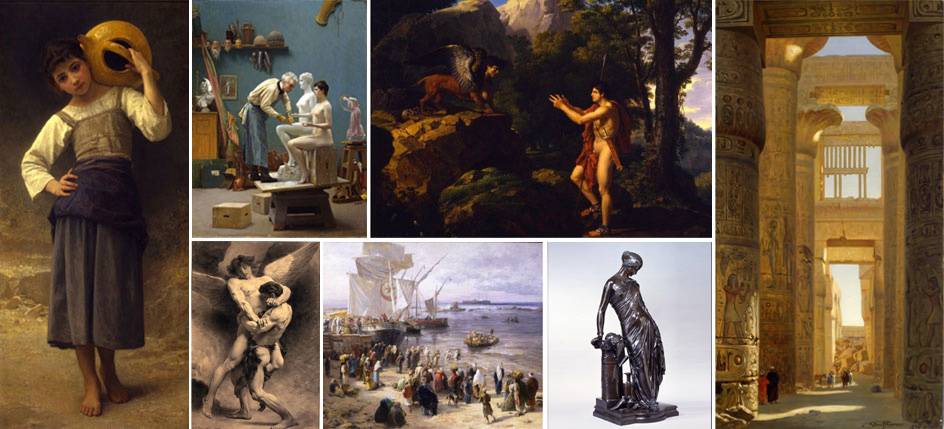The Dahesh Museum of Art has a rich tradition of organizing exhibitions centered on its extensive permanent collection of 19th-century academic art. The curatorial staff has developed a series of exhibitions on subjects that are especially representative of the artists, ideals, and subject matter that dominated academic art during that creative era. The exhibitions listed here range from modestly scaled to substantial and major. In all cases, the exhibition checklist can be tailored to the needs and spaces of the borrowing institution.
For further information, including proposed checklists, estimated figures for transportation and insurance, fees, and scheduling, please contact:
J. David Farmer
Director of Exhibitions
Dahesh Museum of Art
dfarmer@daheshmuseum.org
207-354-6120 or (cell) 207-593-2886
Rediscovering Egypt
The Dahesh Museum Of Art Collection
Napoleon’s invasion of Egypt in 1798, accompanied by scholars, artists, and archaeologists initiated the 19th-century rediscovery of this extraordinary country. Writers, curious travelers, and, most crucially, artists from many European countries followed and explored all aspects of its ancient and contemporary culture. Rediscovering Egypt surveys the Orientalist artist’s role in Egypt from the collection of the Dahesh Museum of Art, the only institution in America devoted exclusively to collecting and exhibiting 19th-century European academic art.
The Dahesh Museum of Art is pleased to make Rediscovering Egypt available, selected from one of the finest collections of Orientalist art in America.
Highlights:
- Selections from Description de l’Égypte, the scholarly product of Napoleon’s brief tenure in Egypt
- Historic recreations by Alma-Tadema, Long and Bridgman
- Evocative land- and city-scapes by Girardet, Frère, and Varley, plus images of ancient Egyptian ruins by Farquharson and Koerner
- Genre scenes by such masters as Girardet, Ernst, and Weeks
- Romantic narratives by Corrodi and Gentz
- A selection of Carter color lithographs and Gérôme photogravures
The Orient Real And Imagined
The Dahesh Museum Of Art Collection
The rediscovery in the late 18th and 19th centuries of the Middle East, Egypt, and Ottoman Turkey — then called the Orient — and its representaiton in art and literature has come to be known as Orientalism. The Orient Real and Imagined is a survey of Orientalist art in all mediums and techniques from the collection of the Dahesh Museum of Art — the only institution in America devoted exclusively to collecting and exhibiting 19th-century academic art — and provides early representations of Ottoman courtiers, romantic but accurate images of the Holy Land, scenes of everyday life, archaeologically correct studies, historic recreations and, finally and ironically, representations catering to the fantasies and preconceptions of Western viewers.
Highlights:
- Historic recreations by Alma-Tadema, Long, and Bridgman
- Evocative land- and city-scapes by Roberts, Carter, Frère, and Varley, plus images of ancient Egyptian ruins by Farquharson, Koerner, and Gentz
- Gustav Bauernfeind’s masterpiece of contemporary Ottoman domination in Jaffa
- Genre scenes by such masters as Ernst, Deutsch, Girardet, Pavesi, and Weeks
- Ethnographic studies by Tapiró Baró, Fromentin, Mønsted, Cordier, and Marcello
- Romantic narrative scenes by Schreyer, Corrodi, and Vernet
- Rare ethnographic prints from the 18th-century Ottoman Court
- A selection of Gérôme photogravures
Masterworks
Selections From The Dahesh Museum Of Art Collection
The Dahesh Museum of Art is the only institution in the United States of America devoted to collecting and exhibiting European academic art of the 19th century. Masterworks features drawings, paintings, and sculptures by creative artists trained in the academies and private ateliers of France and other countries, including Jean-Léon Gérôme, William Adolphe Bouguereau, Alfred Lord Leighton, Lawrence Alma Tadema, Jean-Jacques Pradier, and Léon Bonnat, as well as by lesser known but superbly talented contemporaries. Historical and Orientalist subjects — the two dominant themes — are complemented by portraits, landscapes, and still lifes.
Masterworks is a major, high profile exhibition that can be shaped to the scale and special interests of the borrowing museum.
Highlights:
- Selected drawings from academic studies to finished works
- Cabanel’s monumental envoi as a student at the French Academy in Rome
- Salon works from Bouguereau, Gérôme, and Fabre
- Major Orientalist paintings and sculptures by European travelers to the Middle East
- Paintings by renowned Victorians
- Neo-Classical to Realist landscapes
Reconnecting East And West
Islamic Ornament In 19th-century Works From The Dahesh Museum Of Art
The exhibition and publication trace the remarkably rich documentation of Islamic ornament and design by European scholars, artists, and architects who traveled to the Middle East, North Africa, and Turkey in the 19th century, following the “rediscovery” of the region (which Westerners called the Orient) in the years after 1800. Reconnecting East & West was initially shown in Dubai to strong critical acclaim and includes paintings, prints, and several of the most beautifully printed books published in the 19th century.
Highlights:
- Genre paintings by Rudolph Ernst and Ludwig Deutsch that showcase Islamic architecture and design
- Prints from the Description de l’Égypte and urban views commissioned by Owen Browne Carter
- Owen Jones’s groundbreaking Grammar of Ornament and Alhambra, as well as Émile Prisse d’Avenne’s sumptuous L’Art arabe.
The Essential Line
Drawings From The Dahesh Museum Of Art
The Essential Line celebrates the act of drawing in the 19th century with a selection of the finest works from the collection of the Dahesh Museum of Art, including exceptional examples of the entire range of drawing techniques and subjects: student work, plein-air sketches, studies for paintings, and finished works of art.
A checklist of available drawings and selected images are available on request. The exhibition can be tailored for each museum’s individual needs and spaces.







